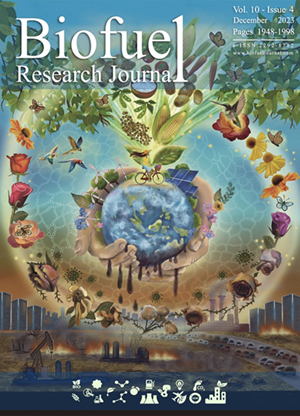混合溶剂(咪唑离子液体和单二乙醇胺)对沼气升级的可持续性分析
IF 11.9
Q1 ENERGY & FUELS
引用次数: 2
摘要
化石燃料可能会大量产生能源,但这与环境问题有关。因此,包括二氧化碳和甲烷在内的可再生资源,如沼气,应单独使用或与化石燃料结合使用,以减轻能源发电系统的环境足迹。本研究提出了一种新的混合溶剂概念,将1-辛基-3-甲基咪唑四氟硼酸盐与单二乙醇胺水溶液相结合用于沼气提质过程,以提供高纯度(≥99wt%)和回收率(≥99wt%)的生物甲烷。该过程在ASPEN Plus®V.11中进行了模拟。根据实验数据验证了热力学框架,并进行了严格的回归以获得二元参数。为了确定所建议的混合溶剂的功效,通过改变与胺连接的离子液体(5–20 wt%)的浓度,并与水性单二乙醇胺(50 wt%)作为基本情况进行比较,研究了三种情况。结果表明,与5wt%的1-辛基-3-甲基咪唑四氟硼酸盐的混合溶剂可以将CH4纯度提高到99%(mol%)。与基于胺的系统相比,混合溶剂导致64.94%的节能。热力学不可逆性表明,与基于胺的程序相比,5wt%的1-辛基-3-甲基咪唑四氟硼酸盐将火用效率提高了54%。在环境方面,混合溶剂系统还实现了更高的捕获率(99%)和更低的排放量(0.017kW/kmol)。比较经济前景,5wt%的1-辛基-3-甲基咪唑四氟硼酸盐节省了56%的总资本成本,从投资角度来看具有竞争力。本文章由计算机程序翻译,如有差异,请以英文原文为准。
Exergy-based sustainability analysis of biogas upgrading using a hybrid solvent (imidazolium-based ionic liquid and aqueous monodiethanolamine)
Energy may be generated in large quantities from fossil fuels, but this comes with environmental concerns. Thus, renewable resources like biogas, comprising carbon dioxide and methane, should be used alone or in combination with fossil fuels to mitigate the environmental footprints of energy generation systems. In this study, a new concept of hybrid solvent was presented, which combines 1-octyl-3-methylimidazolium tetrafluoroborate with aqueous mono diethanolamine for biogas upgrading process to provide high purity (≥ 99 wt%) and recovery (≥ 99 wt%) of biomethane. The process was simulated in ASPEN Plus® V.11. The thermodynamic framework was validated against experimental data, and rigorous regression was conducted to obtain binary parameters. To establish the efficacy of the suggested hybrid solvent, three scenarios were studied by altering the concentration of ionic liquid (5–20 wt%) linked with amine and compared to aqueous mono diethanolamine as the base case (50 wt%). The results showed that a hybrid solvent with 5 wt% 1-octyl-3-methylimidazolium tetrafluoroborate could increase CH4 purity to 99% (mol%). The hybrid solvent led to an energy saving of 64.94% compared to the amine-based system. Thermodynamic irreversibilities showed that 5 wt% 1-octyl-3-methylimidazolium tetrafluoroborate improved exergy efficiency by 54% over the amine-based procedure. Environmentally, the hybrid solvent system also achieved a higher capture rate (99%) and lower emissions (0.017 kW/kmol). Comparing the economic prospects, 5 wt% 1-octyl-3-methylimidazolium tetrafluoroborate saved 56% on total capital cost, making it competitive from an investment perspective.
求助全文
通过发布文献求助,成功后即可免费获取论文全文。
去求助
来源期刊

Biofuel Research Journal-BRJ
ENERGY & FUELS-
CiteScore
22.10
自引率
1.50%
发文量
15
审稿时长
8 weeks
期刊介绍:
Biofuel Research Journal (BRJ) is a leading, peer-reviewed academic journal that focuses on high-quality research in the field of biofuels, bioproducts, and biomass-derived materials and technologies. The journal's primary goal is to contribute to the advancement of knowledge and understanding in the areas of sustainable energy solutions, environmental protection, and the circular economy. BRJ accepts various types of articles, including original research papers, review papers, case studies, short communications, and hypotheses. The specific areas covered by the journal include Biofuels and Bioproducts, Biomass Valorization, Biomass-Derived Materials for Energy and Storage Systems, Techno-Economic and Environmental Assessments, Climate Change and Sustainability, and Biofuels and Bioproducts in Circular Economy, among others. BRJ actively encourages interdisciplinary collaborations among researchers, engineers, scientists, policymakers, and industry experts to facilitate the adoption of sustainable energy solutions and promote a greener future. The journal maintains rigorous standards of peer review and editorial integrity to ensure that only impactful and high-quality research is published. Currently, BRJ is indexed by several prominent databases such as Web of Science, CAS Databases, Directory of Open Access Journals, Scimago Journal Rank, Scopus, Google Scholar, Elektronische Zeitschriftenbibliothek EZB, et al.
 求助内容:
求助内容: 应助结果提醒方式:
应助结果提醒方式:


